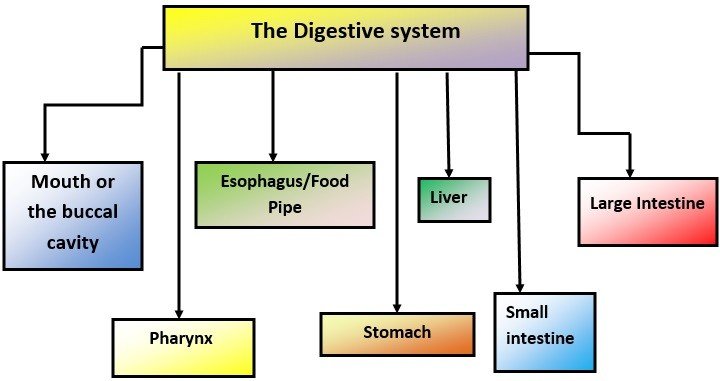Human Digestive System (Worksheets, Parts of the Digestive System, and Diagram)
Grade 7 Science Worksheets
The human digestive system is a complex network of organs and processes responsible for breaking down food, absorbing nutrients, and eliminating waste. It starts with the mouth, where food is chewed and mixed with saliva, then moves through the esophagus to the stomach, where it is further broken down. The small intestine is where most digestion and nutrient absorption occur, with the help of the liver and pancreas. The large intestine absorbs water and electrolytes, forming waste that is stored in the rectum and eliminated through the anus. Throughout this process, muscles, hormones, nerves, and enzymes work together to facilitate digestion and maintain bodily functions.
The Digestive System is one of the vital systems of all living beings. The food we eat gets converted to the much needed energy only due to our digestive system. All the organs of this system work in perfect synchronization to ensure that maximum nutrition is extracted from this food and passed on to our Circulatory System.
Schedule a Free session to clear worksheet doubts
No credit card required, no obligation to purchase.
Just schedule a FREE Sessions to meet a tutor and get help on any topic you want!
What are the organs of the digestive system? | Human Digestive System Worksheets

How does food move through the digestive system?
The Digestive system is also called alimentary canal and it is supported by organs like teeth, tongue, liver, and others. The digestive system helps to convert food into energy and nutrients to nourish the body. The food we take in is thoroughly digested and absorbed by our body and the wastes are eliminated through the excretory system. The alimentary canal is a lengthy tube through which the food goes down to our system. It starts at the mouth or the oral cavity going through the pharynx, esophagus or food pipe, stomach, small intestines, large intestines, rectum andanus. The food particles get digested in every stage of the alimentary canal as they move.
Oral /Mouth and the Buccal Cavity
The mouth has many accessory organs such as the tongue, teeth, and salivary glands, which help in the digestion of food. Food starts the first step of digestion in the mouth, also known as the buccal cavity or the oral cavity. Food is grinded by the teeth. Salivary amylase is the digestive juices given off by the salivary glands. This moistens the food, and break the food down into usable and absorbable components and then the food is pushed down into the pharynx.

Pharynx
The pharynx acts as a passage for the chewed food from the mouth to the esophagus. It has a flap of tissue known as the epiglottis preventing the food from getting into the wind pipe and helps us from getting choked while we eat.
Esophagus or Food Pipe
The esophagus is a tube joining the pharynx to the stomach. It is made of flexible muscle to help pushing of food easily. It carries swallowed food down its long tube and pushes it to the stomach.
Stomach
The stomach is a thick-wall made of muscle in the form of a bag that is located on the left side of the abdominal cavity. It is the largest part of our digestive system. Stomach acts as a storage place for food. And slowly digests food. It gets food from the food pipe and sends it to the small intestine. The stomach has digestive acids which help reduce food into further absorbable substances. Mucous protects the inner walls of the stomach. This can otherwise get damaged while digesting food. Because the acid reacts with the bacteria and kills it that enters our body with food. The digestive enzymes break down proteins into simpler substances.
Small Intestine
The small intestine is just named small. But it is the longest part our digestive system. It is made in such a way that it is highly coiled; it’s quite thin tubular form but still about 7.5 meters long. (The length of the small intestine depends on the diet of the organism.) A major proportion of digestion takes place in the small intestines. Nutrients get digested here. The walls of the small intestine also secrete juices for digesting food. The enzymes in the intestine convert the carbohydrates into glucose, proteins to amino acids and fats into fatty acids and glycerol.
Liver
The liver releases bile. This neutralizes the acidity level of the food. The pancreatic juice digests the proteins and lipids. Once the food is broken down into the simple particles, it is ready to be absorbed by the body. The absorbed food is then carried to different parts of the body through the blood vessels for cell activities.
Large Intestine
The large intestine is a thicker tube than the small intestine. The large intestine absorbs water and left over nutrients from the remaining food with the help of many bacteria in it. The remaining food waste passes into the rectum, where it is ready to get out as semi-solid wastes. Feces then are excreted by the body through the anus.
Learn more about Digestive System and other important topics with 7th Grade Science Tutoring at eTutorWorld. Our expert science tutors break down the topics through interactive one-to-one sessions. We also offer the advantage of customized lesson plans, flexible schedules and convenience of learning from home.
eTutorWorld Understands Math Tutoring | Online Math Worksheets are Important Tools
Understanding graphs, charts, and opinion polls in a newspaper, for calculating house and car payments, and for choosing a long-distance telephone service are impossible without strong math skills …and the only way to develop strong math skills is by constant practice.
‘Practice makes a man perfect’ holds true for no other field better than for math. A middle or high school student must set aside a minimum of an hour for math every day. Other than textbooks, worksheets help you revise and understand concepts better.
Our expert tutors prepare online maths worksheets that are age and grade-appropriate. Grade-wise math worksheets for Elementary Math, Arithmetic, Pre-Algebra, Algebra, Geometry, Trigonometry, Statistics, Pre-Calculus and Calculus can be solved to improve math skills, to get ahead or to even catch up.
You may download these FREE online math worksheets in the PDF format, and then print and email us their solutions for a free evaluation and analysis by eTutorworld’smath expert tutors.
You may solve these worksheets by yourself or with your peers while studying together.
The Answer Key at the end of each worksheet allows for a self-evaluation.
Personalized Online Tutoring
eTutorWorld offers affordable one-on-one live tutoring over the web for Grades K-12, Test Prep help for Standardized tests like SCAT, CogAT, MAP, SSAT, SAT, ACT, ISEE and AP. You may schedule online tutoring lessons at your personal scheduled times, all with a Money-Back Guarantee. The first one-on-one online tutoring lesson is always FREE, no purchase obligation, no credit card required.
For answers/solutions to any question or to learn concepts, take a FREE CLASS.
No credit card required, no obligation to purchase.
Just book a free class to meet a tutor and get help on any topic you want!
Sample Questions
Q1. Identify organs involved in digestion –
A. I deliver food to stomach by means of series of muscular contractions called ‘Peristalsis’.____________
B. I act as a hollow container that holds food and secrete HCL.____________
C. I am the largest gland in the body and helps in bile secretion.____________
D. I am responsible to produce a watery secretion that helps to moisten food and begins the digestion of carbohydrates.____________
E. I am a long muscular tube and helps in absorption of food. I have millions of VILLI that increase the food absorption area._____________
Q2. Define these terms –
A. Digestion :__________________________________________________
B. Absorption :_________________________________________________
C. Bile Juice:__________________________________________________
D. Mechanical Digestion :__________________________________________
E. Peristalsis :__________________________________________________
Check Point
I. Fill in the blanks –
- The ……………………..……………is the long tube through which the food that we eat is passed.
- The flap of tissue known as the ……………… present in pharynx prevents food from entering into the wide pipe.
- The enzymes in the intestine convert the ………………. into glucose, proteins to …………….. and fats into fatty acids and glycerol.
- The liver releases ………. juice which neutralizes the acidic food received from the stomach and also converts the fat.
- The ……………… ……… digests the proteins and lipids.
II. State True or False –
- The digestive system of is a system of organs working together to eliminate waste products out of the body.
- The esophagus is a tube joining the pharynx to the stomach made of flexible muscle to ease pushing of food.
- Mucous protects the lining of the stomach while acid kills bacteria that enter the body along with the food.
- The small intestine is the smallest part of the human digestive system.
- A major proportion of digestion takes place in the large intestines.
Answer Key
I. Fill in the blanks –
- Alimentary canal
- Epiglottis
- Carbohydrates , Amino acids
- Bile
- Pancreatic juice
II. State True or False –
- False
- True
- True
- False
- False
What is the primary function of the digestive system?
The digestive system’s main function is to break down food, extract nutrients, and eliminate waste from the body.
How long does digestion typically take?
The duration of digestion varies depending on factors such as the type of food consumed, individual metabolism, and overall health. Generally, it takes around 24 to 72 hours for food to pass through the entire digestive system.
What role does stomach acid play in digestion?
Stomach acid, primarily composed of hydrochloric acid, helps break down food, kill bacteria, and activate digestive enzymes. It creates an acidic environment that aids in the breakdown of proteins and promotes optimal digestion.
What are the essential organs involved in digestion?
The major organs involved in digestion are the mouth, esophagus, stomach, small intestine, large intestine (colon), liver, pancreas, and rectum. Each organ performs specific functions to ensure effective digestion and nutrient absorption.
Pricing for Online Tutoring
| Tutoring Package | Validity | Grade (1-12), College |
|---|---|---|
| 5 sessions | 1 Month | $139 |
| 1 session | 1 Month | $28 |
| 10 sessions | 3 months | $269 |
| 15 sessions | 3 months | $399 |
| 20 sessions | 4 months | $499 |
| 50 sessions | 6 months | $1189 |
| 100 sessions | 12 months | $2249 |
IN THE NEWS

Our mission is to provide high quality online tutoring services, using state of the art Internet technology, to school students worldwide.
Online test prep and practice
SCAT
SSAT
ISEE
PSAT
SAT
ACT
AP Exam
Science Tutoring
Physics Tutoring
Chemistry Tutoring
Biology Tutoring
Math Tutoring
Pre-Algebra Tutoring
Algebra Tutoring
Pre Calculus Tutoring
Calculus Tutoring
Geometry Tutoring
Trigonometry Tutoring
Statistics Tutoring
Quick links
Free Worksheets
Fact sheet
Sales Partner Opportunities
Parents
Passive Fundraising
Virtual Fundraising
Our Expert Tutors
Safe and Secure Tutoring
Interactive Online Tutoring
After School Tutoring
Elementary School Tutoring
Middle School Tutoring
High School Tutoring
Home Work Help
Math Tutors New York City
Press
©2022 eTutorWorld Terms of use Privacy Policy Site by Little Red Bird
©2022 eTutorWorld
Terms of use
Privacy Policy
Site by Little Red Bird






